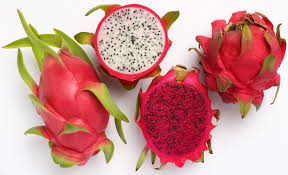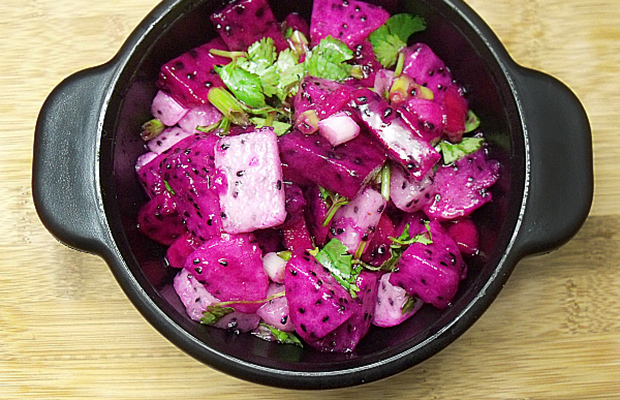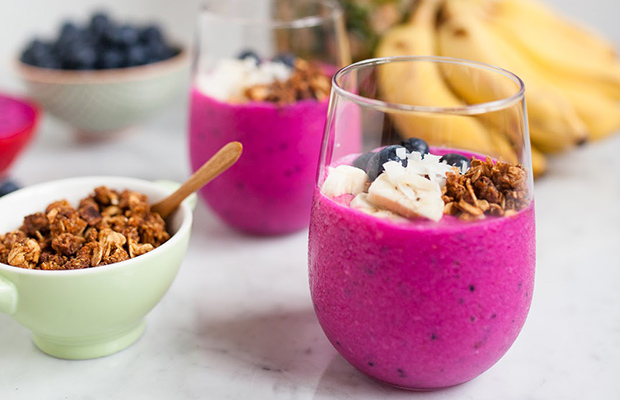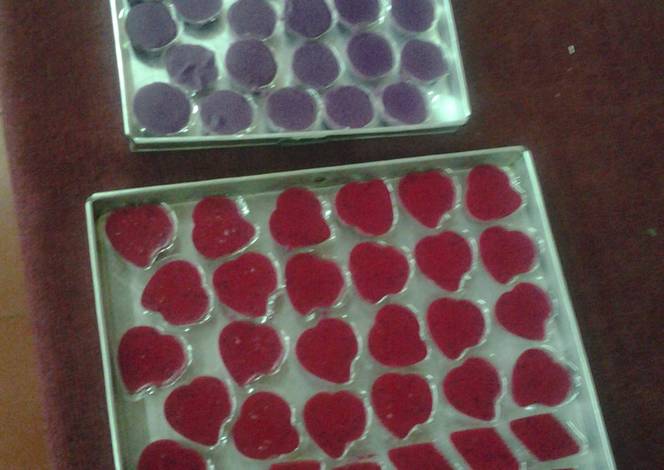Dragon fruit is in the shape of a football. It has sweet, crunchy flesh with lots of small black seeds. As a member of the cactus family, the dragon fruit has an appetizing taste suggestive of both pear and kiwi. A bite into the crunchy flesh not only gives you a refreshing treat, but also provides you with many essential nutrients.

Dragon Fruit Nutrition
1. Low Calories
Dragon fruit is a delicious but low-calorie food, which contains only 60 calories in each 100 gram serving. Of these, 34 calories come from carbohydrates, 18 from unsaturated fat and 8 from protein. This makes dragon fruit a perfect snack for weight loss.
2. No Cholesterol, Healthy Fats
Dragon fruits are cholesterol-free and don't contain unhealthy fats such as saturated fat and trans fat, which helps stabilize blood pressure and cholesterol level. Their seeds are rich in omega-3 and omega-6 fatty acids. These nutrients protect against cardiovascular problems.
3. Fiber
Dragon fruits have high fiber content that improves digestion, prevents constipation and aids in weight reduction. This fiber is indigestible and acts as prebiotics, which supports growth of healthy bacteria such as bifidobacteria and lactobacilli.
4. Vitamins
Dragon fruits are rich in nutrients, including:
- Vitamin A: It supports night vision, skin health and detoxification of the body.
- Vitamin B1: It helps in metabolism of carbohydrates.
- Vitamin B2: It improves appetite.
- Vitamin B3: It reduces bad cholesterol and improves skin condition.
- Vitamin B12: It helps in the production of red blood cells and proper working of the nervous system.
- Vitamin C: It strengthens your immunity and helps in faster recovery from ailments.
- Vitamin E: It promotes healthy skin and healthy blood viscosity, and protects against toxins.
5. Minerals
Dragon fruit nutrition provides a rich store of essential minerals, including:
- Calcium: It helps build strong bones and teeth.
- Iron: It assists blood production.
- Phosphorus: It is essential in building healthy tissues.
- Zinc: It aids in brain function and control of appetite.
- Magnesium: It helps in regulation of body temperature, production of energy and detoxification.
- Potassium: It is required for carbohydrate metabolism, regulation of blood pressure and maintenance of cardiovascular health.
- Copper: It helps maintain healthy bones, tissues and thyroid gland.
6. Antioxidants
Dragon fruit pulp contains several antioxidants, including:
- Flavonoids: This group of antioxidants is associated with healthier brain and heart.
- Betalains: Betalains are antioxidants found in deep red pigmented foods. They protect LDL cholesterol from oxidation or damage.
- Hydroxycinnamates: Their anti-cancer properties have been demonstrated in animal studies.
- Phytoalbumins: Phytoalbumins present in dragon fruits have antioxidant qualities, believed to prevent growth of cancer cells. The fruits also detoxify the body to excrete heavy metals.
- Lycopene: Dragon fruits contain lycopene, signified by the red pigment. Research shows that lycopene has cancer-preventing properties.
Dragon Fruit Nutrition Facts
|
Nutrient |
Amount per 100 g |
|
Protein |
2.0 g |
|
Lycopene |
14.35 mg |
|
Vitamins |
|
|
Vitamin A |
20 µg |
|
Vitamin B1 |
48.9 µg |
|
Vitamin B12 |
16 µg |
|
Vitamin C |
500 mg |
|
Vitamin E |
106 µg |
|
Minerals |
|
|
Potassium |
57 mg |
|
Magnesium |
28 mg |
|
Phosphorus |
23 mg |
|
Zinc |
14 mg |
|
Calcium |
5.7 mg |
|
Iron |
3.4 mg |
|
Copper |
31 µg |
Tasty Recipes of Dragon Fruit
You can enjoy dragon fruit by cutting it in half and scooping the flesh with a spoon, or by peeling it, cutting it in quarters and eating from a plate. It usually tastes better when chilled. You can also cut your dragon fruit into cubes to make juice, salad or even smoothie. Whichever way you eat it, enjoy all the benefits of dragon fruit nutrition.
1. Dragon Fruit Salad

Ingredients
- 1 cup dragon fruit
- 1 cup pineapple pieces
- 1 sliced banana
- 1 cup sliced strawberries
- 1 cup mango cubes
- 1½ cups papaya cubes
Salad Dressing
- ¼ cup coconut milk
- 1 tablespoon fresh lime juice
- 2 tablespoons stevia or brown sugar
Directions
- Make your salad dressing by mixing the ingredients in a bowl until the stevia/sugar has dissolved, and set aside.
- Put all the salad fruits into another bowl and pour your salad dressing on top; then mix.
- Place the fruit salad in a pineapple boat or a serving bowl. When you are ready to serve, sprinkle with lime juice.
2. Dragon Fruit and Coconut Power Smoothie

Ingredients
- 1 dragon fruit (flesh)
- ½ cup blueberry
- 1 banana
- 1 tablespoon chia seeds
- 1 tablespoon flaxseeds, ground
- A handful of pumpkin seeds
- 1 tablespoon virgin coconut oil
- 1 scoop of vanilla bone broth
- 1 ¾ cups water
Directions
- Blend dragon fruit, blueberries, banana and water.
- Add chia seeds, flaxseeds, coconut oil and bone broth, and blend some more. Add ice cubes for a chilled smoothie, or use a frozen banana to make the smoothie thicker.
- Top the smoothie with the pumpkin seeds.
3. Red Dragon Fruit Pudding
Ingredients
- 2 pieces dragon fruit (red)
- 2 packs plain jelly
- 300 g granulated sugar
- 600 ml milk
- 100 ml coconut milk
- 200 ml water
Directions
- Blend the dragon fruit with the water.
- Put milk, coconut milk and the jelly in a saucepan and cook until it starts to boil. Add the dragon fruit puree and continue cooking until it boils.
- Let the mixture cool a bit, and then pour it into a mold or glass.
- Refrigerate.

